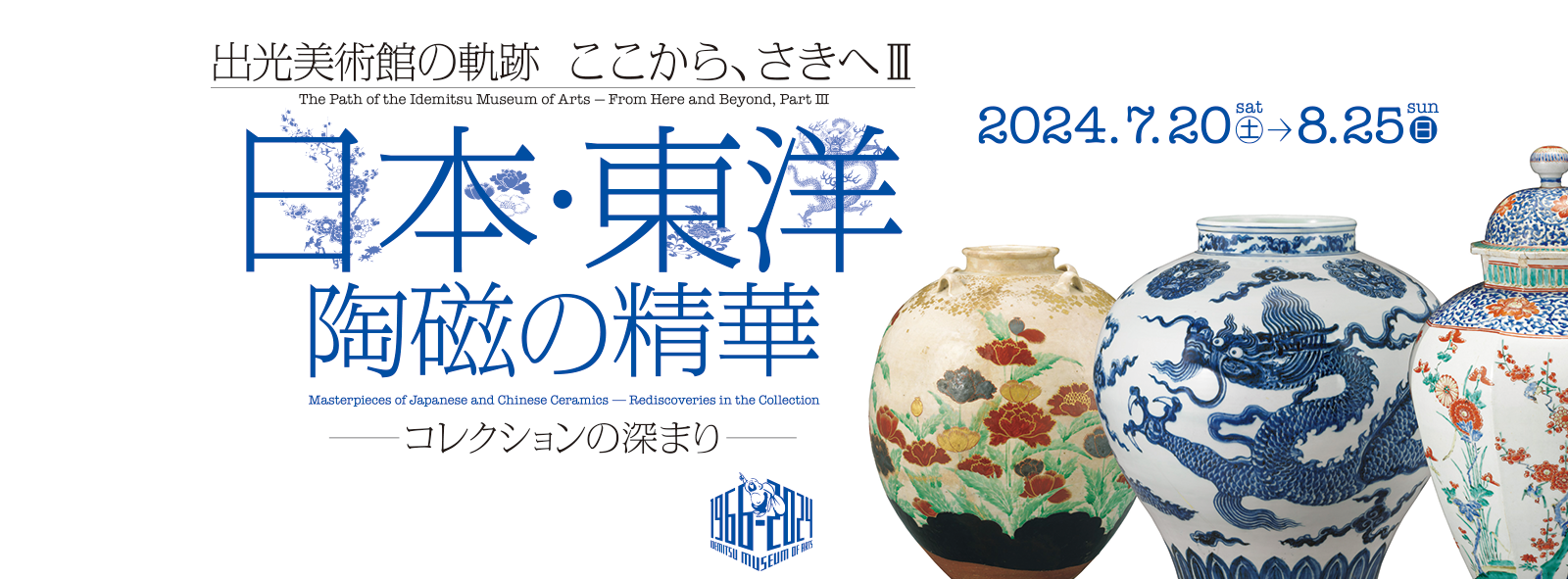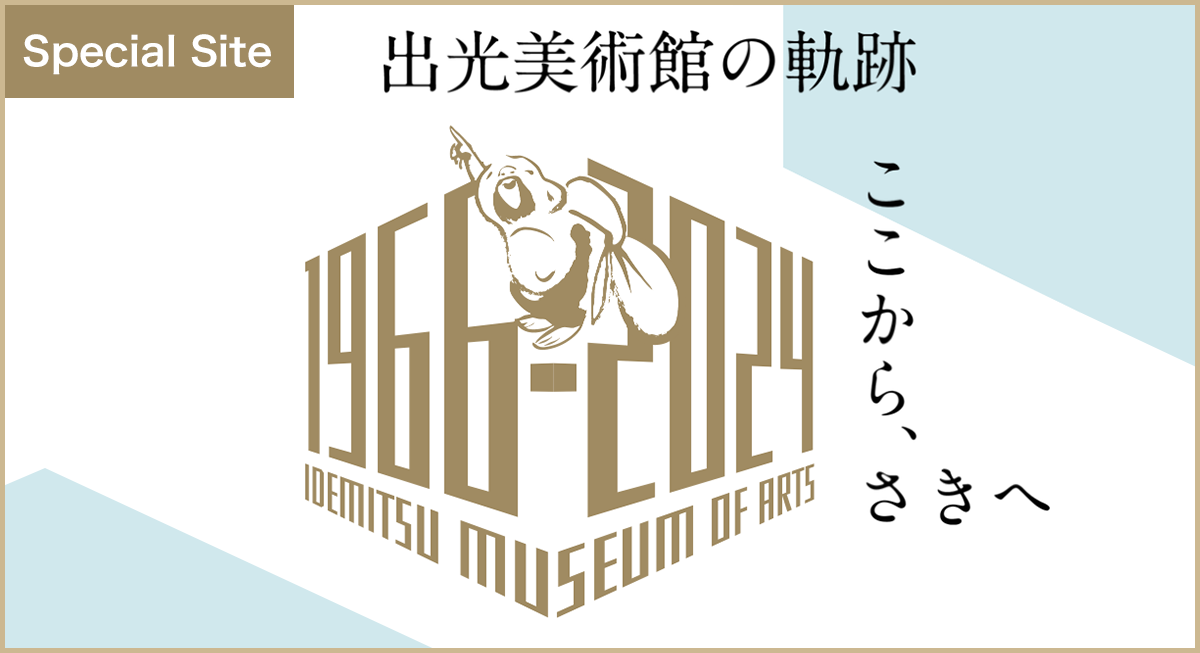Information
Student Free Days will be held July 20 – 26
Reservation is not required to visit the museum. For tickets, see here.
The Museum holds only temporary exhibitions featuring its own collection.
Hours
10:00 a.m. - 5:00 p.m. (Entrance until 4:30 p.m.)
Friday : 10:00 a.m. - 7:00 p.m. (Entrance until 6:30 p.m.)
Closed
Mondays (Excluding holidays. The Museum will be open on that Monday and closed the following day.) and during the change of exhibits
Admission
- Adults: ¥1,200
- High School and College Students: ¥800
- Junior High School Students or Younger: Free (with Parent or Guardian)
* ¥200 Discount for Persons with Disability with Presentation of the Physical Disability Certificate and Free Admission for 1 Caretaker
* Groups of 20 or more receive discount of ¥200 each
Address
Idemitsu Museum of Arts
9th Floor, Teigeki Bldg., 3-1-1, Marunouchi, Chiyoda-ku, Tokyo, 100-0005
TEL
050-5541-8600 (General Information)
Directions
JR
Yamanote Line: 5-minute walk from the International Forum Exit of Yūrakuchō station
Tokyo Metro
Yūrakuchō Line: 3-minute walk from B3 Exit of Yūrakuchō Station
Hibiya Line and Chiyoda Line:3-minute walk from B3 Exit of Hibiya Station (via underground passage)
Toei Subway
Mita Line: 3-minute walk from B3 Exit of Hibiya Station
For Use of Wheelchairs
The Museum has a slope in Room 1. For those who need guidance, please visit the General Information desk. The Museum also rents wheelchairs for those in need (3 available).
Further, the Museum does not have restrooms for wheelchair-users. For visitors who would like to use one, please use the restroom on the B1 Floor in the same Teigeki building. For more information, please visit the General Information desk.
For Visitors with Infants
Please request the General Information desk if you would like to care for your child (such as breastfeeding and changing of diapers). The Museum staff will give guidance to the appropriate space within the Museum.
Idemitsu Museum of Arts
The Idemitsu Museum of Arts opened in 1966 as an exhibition hall for the Idemitsu Collection. The building is located on the 9th floor of the Imperial Theater Building looking down over the beautiful Imperial Garden in Marunouchi, Chiyoda-ku, Tokyo. The museum is designed to incorporate the Japanese spirit of hospitality in the setting of the modern building and invites visitors to enjoy the artworks in a comfortable and relaxed atmosphere. Special exhibitions are held about six times a year, with themed exhibitions of selected works from the Idemitsu Collection of Japanese painting and calligraphy, and East Asian ceramics. Other attractions include a year-round exhibition of major works by Georges Rouault (1871-1958), the French master of religious paintings who is famous for the series called “Passion” depicting the last days of life of Jesus Christ. The unique feature of the Museum is the Ceramic Sherd Room where fragments of pottery collected from kilns around Asia and Egypt (Fustat site, Cairo) are displayed.
About the Idemitsu collection
The Idemitsu Collection includes representative works of Eastern Asian ancient art, gathered over 70 years by Sazo Idemitsu (1885-1981), founder of the Idemitsu Kosan Co.,Ltd., and the Museum. This extensive collection includes Japanese painting (yamato-e, rimpa, bunjin-ga, ukiyo-e, and works by the Zen painter Sengai and modern painter Kosugi Hōan, etc.) and calligraphy, East Asian ceramics (Chinese, Japanese, and Korean wares, and works of modern ceramicist, Itaya Hazan, etc.). The collection also holds works of Western painters (Georges Rouault). There are a total of fifteen thousand items, including two National Treasures and fifty-four Important Cultural Properties.
Guidelines for Enjoying the Museum
The museum visitors are reminded of the following for enjoying the Museum by the other visitors as well as for the protection of the exhibits.
- Do not speak loudly as the low ceiling of the Museum tends to reflect the voice easily.
- The temperature and lighting level are controlled at its best for the preservation of the exhibits. For this reason, the exhibition rooms may feel cold or a bit dark for walking.
- Do not touch the exhibits and the display cases.
- Do not use the ballpoint pens, mechanical pencils, fountain pens or brushes which may stain the exhibits. Please contact the staff at the Information Desk or the Reception for pencils.
- Please switch off and do not use mobile phones or activate the silent mode while in the Museum. Should there be a need to use the mobile phone, please do so in the Elevator Hall. The staff at the Information Desk or the Reception will provide the re-entry ticket.
- Do not take photographs (except for taking the view from the windows in the Lobby).
- Do not eat or drink any food or beverages (such as candies, chewing gums, bottled drinks, etc.) brought in from outside.
- Free tea vending machines are available in the Lobby but their drinking is limited only in the rest area with sofas in the Lobby.
- Do not lay down on the benches in the exhibition rooms or run around in the Museum.
- Do not smoke in the Museum (including the Elevator Hall).
- Do not bring in the large luggage. Please leave them in the locker (free with the coin return system) or ask the staff at the Information Desk for further assistance.
- Leave the umbrellas at the umbrella stand.
- Do not bring in any animals and pets, except for guide or service dogs.
- Do not bring in any dangerous materials.
- The use of lockers, toilets and other museum facilities are limited only after the entry into the Museum.
- The sales of Museum’s free admission tickets to ticket brokers and in the internet auctions are prohibited. Please also refrain from giving and transferring tickets to others near and around the Museum entrance.
- Do not engage in acts or behavior which may disturb or annoy the others.
Lastly we also ask you to follow other instructions of the museum staffs when requested.



